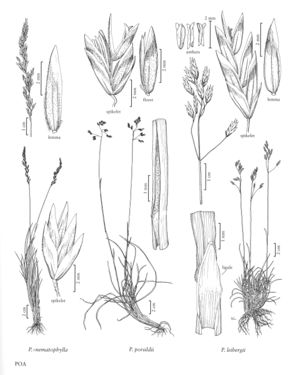Difference between revisions of "Poa ×nematophylla"
FNA>Volume Importer |
imported>Volume Importer |
||
| (8 intermediate revisions by 2 users not shown) | |||
| Line 6: | Line 6: | ||
|synonyms={{Treatment/ID/Synonym | |synonyms={{Treatment/ID/Synonym | ||
|name=Poa cusickii subsp. pubens | |name=Poa cusickii subsp. pubens | ||
| − | |authority= | + | |authority= |
| + | |rank=subspecies | ||
}} | }} | ||
|hierarchy=Poaceae;Poaceae subfam. Pooideae;Poaceae tribe Poeae;Poa;Poa subg. Poa;Poa sect. Madropoa;Poa subsect. Epiles;Poa ×nematophylla | |hierarchy=Poaceae;Poaceae subfam. Pooideae;Poaceae tribe Poeae;Poa;Poa subg. Poa;Poa sect. Madropoa;Poa subsect. Epiles;Poa ×nematophylla | ||
| Line 19: | Line 20: | ||
-->{{Treatment/Body | -->{{Treatment/Body | ||
|distribution=Colo.;Idaho;Mont.;Utah;Wyo.;N.Dak.;Alta.;B.C.;Man.;Sask. | |distribution=Colo.;Idaho;Mont.;Utah;Wyo.;N.Dak.;Alta.;B.C.;Man.;Sask. | ||
| − | |discussion=<p>Poa ×nematophylla is believed to consists of hybrids between P. cusickii subsp. pallida (see previous) and P. fendleriana (p. 556). It is mostly pistillate and apomictic; few staminate plants have been found. It usually resembles P. cusickii most, but grades towards P. fendleriana. It tends to grow on drier slopes than either parent, mainly in and around sagebrush desert/forest interfaces.</p> | + | |discussion=<p><i>Poa ×nematophylla</i> is believed to consists of hybrids between <i>P. cusickii </i>subsp.<i> pallida</i> (see previous) and <i>P. fendleriana</i> (p. 556). It is mostly pistillate and apomictic; few staminate plants have been found. It usually resembles <i>P. cusickii</i> most, but grades towards <i>P. fendleriana</i>. It tends to grow on drier slopes than either parent, mainly in and around sagebrush desert/forest interfaces.</p> |
|tables= | |tables= | ||
|references= | |references= | ||
| Line 28: | Line 29: | ||
-->{{#Taxon: | -->{{#Taxon: | ||
name=Poa ×nematophylla | name=Poa ×nematophylla | ||
| − | |||
|authority=Rydb. | |authority=Rydb. | ||
|rank=species | |rank=species | ||
| Line 35: | Line 35: | ||
|basionyms= | |basionyms= | ||
|family=Poaceae | |family=Poaceae | ||
| + | |illustrator=Sandy Long | ||
| + | |illustration copyright=Utah State University | ||
|distribution=Colo.;Idaho;Mont.;Utah;Wyo.;N.Dak.;Alta.;B.C.;Man.;Sask. | |distribution=Colo.;Idaho;Mont.;Utah;Wyo.;N.Dak.;Alta.;B.C.;Man.;Sask. | ||
|reference=None | |reference=None | ||
| Line 40: | Line 42: | ||
|publication year= | |publication year= | ||
|special status= | |special status= | ||
| − | |source xml=https:// | + | |source xml=https://bitbucket.org/aafc-mbb/fna-data-curation/src/200273ad09963decb8fc72550212de541d86569d/coarse_grained_fna_xml/V24/V24_786.xml |
|subfamily=Poaceae subfam. Pooideae | |subfamily=Poaceae subfam. Pooideae | ||
|tribe=Poaceae tribe Poeae | |tribe=Poaceae tribe Poeae | ||
Latest revision as of 17:25, 11 May 2021
Plants perennial; densely tufted, not stoloniferous, not rhizomatous. Basal branching intra-vaginal. Culms 10-35 cm, erect or the bases decumbent; nodes terete, 0-1 exserted. Sheaths closed for 1/4-3/4 their length, terete, apices acuminate; innovation blades 0.5-1(2) mm wide, involute, moderately thick, moderately firm, abaxial surfaces smooth or scabrous, adaxial surfaces usually densely scabrous or hispidulous; cauline blades usually gradually reduced distally, 0.5-1(2) mm wide, flat, folded, or involute, thin, sometimes withering, abaxial surfaces smooth or scabrous, apices narrowly prow-shaped, sometimes the flag leaf blades vestigial. Panicles 2-8 cm, erect, narrowly lanceoloid to ovoid, contracted, congested; nodes with 1-2 branches; branches 0.5-3 cm, erect, terete to angled, scabrous. Spikelets 4-8 mm, lengths to 3 times widths, broadly lanceolate to narrowly ovate, laterally compressed, not sexually dimorphic; florets 2-5; rachilla internodes 0.5-1.2 mm, smooth or scabrous. Glumes lanceolate, distinctly keeled; lower glumes 3-veined, distinctly shorter than the lowest lemmas; calluses glabrous; lemmas 4-7 mm, lanceolate, distinctly keeled, membranous, keels and marginal veins usually softly puberulent, sometimes short-villous, intercostal regions usually glabrous, infrequently softly puberulent proximally, lateral veins moderately prominent, margins glabrous, apices acute; palea keels scabrous; anthers mostly vestigial (0.1-0.2 mm), rarely 2-3 mm. 2n = unknown.
Distribution
Colo., Idaho, Mont., Utah, Wyo., N.Dak., Alta., B.C., Man., Sask.
Discussion
Poa ×nematophylla is believed to consists of hybrids between P. cusickii subsp. pallida (see previous) and P. fendleriana (p. 556). It is mostly pistillate and apomictic; few staminate plants have been found. It usually resembles P. cusickii most, but grades towards P. fendleriana. It tends to grow on drier slopes than either parent, mainly in and around sagebrush desert/forest interfaces.
Selected References
None.
